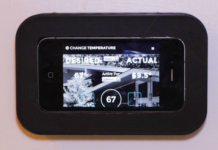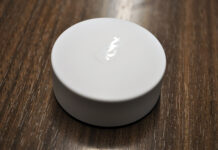If you haven’t automated your home yet, maybe you simply don’t know where to start…
Today, we’ll outline 10 very basic smart home projects for complete beginners combining minimum effort and maximum reward.
We’ll jump right on in without further ado…
1) Mesh WiFi Network: Improve Connectivity and Keep Smart Devices Secure
If you plan to set up a connected home, you’ll need robust WiFi connectivity as well as peace of mind that the network is fully secured.
The problem is, traditional routers are not always the best solution. Particularly in larger homes, a patchy signal can lead to dead spots.
This is merely inconvenient if you’re trying to stream a YouTube video. How about if it leads to a malfunction in your home security system, though?
We looked recently at how mesh WiFi networks offer much stronger coverage by using multiple appliances called nodes to improve signal with blanket coverage.
The GRYPHON Mesh WiFi System is a great choice if you’re looking to start building out a secure and dependable connected home. Why is that?
You’ll get both 2.4GHz and 5GHz networks giving you the ideal combination of speed and barrier penetration. The lower frequency of regular WiFi networks is better at bypassing obstacles like walls. The 5GHz frequency is faster and you’ll get much less interference. Putting both together expands your options without the hassle of switching networks manually.
You can use this device alone or expand your mesh system by investing in extra units. Each unit covers a class-leading 3000 square feet. You’ll be able to stream and download while browsing and controlling your smart devices with no lag or flat spots in all corners of your home.
Setting the network up is straightforward. You can take care of everything in the intuitive app. You’ll also be able to manage all connected devices and parental controls in-app.
The GRYPHON scans all devices (including smart devices) for any vulnerabilities. It uses AI to detect any malware along with any intrusion on your network.
If you want first-rate WiFi coverage with reliability and security uppermost, the GRYPHON mesh system is a beginner-friendly introduction to mesh networks. Don’t be intimidated: start your new smart home the right way!
2) A Great Home Hub as a Foundation for Your Connected Home
A home hub is a central device that allows smart home tech from different manufacturers to communicate seamlessly. Not all smart devices use the same communication protocol. A hub will translate messages and enable them to work in harmony.
While we could recommend a range of different gateways, we’ll suggest the stellar Wink Hub 2 if you’re a complete beginner.
By investing in Wink Hub 2, you’ll be able to use your smartphone as a universal remote controller for any compatible devices. If you also pick up an Alexa or Google Home device, you can use voice commands. We’ll explore this further directly below.
The Wink is compatible with hundreds of smart home devices across all categories. All major communication protocols are supported. We won’t blind you with terminology here but if you’re interested in learning more, check out our look at Zigbee and Z-Wave. These are two of the major protocols both supported by Wink.
Setting up this hub couldn’t be easier using either WiFi or Ethernet.
Once you’re up and running, you’ll be able to automate and schedule devices. You can control them in-app on your smartphone or using voice commands. From Nest and Philips to Ring and Honeywell, take charge of them all even if they speak different languages.
3) Smart Speaker with Integrated Hub
Even if you don’t yet own any smart devices, you’ll doubtless be aware of smart speakers.
As well as allowing you to stream audio, these nifty little devices come with digital assistants onboard. You can use these virtual butlers to control various devices and appliances in your smart home with voice commands.
Google Home speakers use Google Assistant, Apple HomePod the ubiquitous Siri, and Amazon’s Echo range feature Alexa.
If you’re just starting down the home automation route, Amazon’s Echo Plus is a very wise bet.
If you’re not sure whether you want to commit to a home hub, Echo Plus comes with an integrated Zigbee hub included. This will give you a taster of using voice control without needing a third-party gateway to start with.
This second generation Echo Plus has new and improved audio capability. You’ll be able to stream from Spotify, YouTube, Amazon Music, Pandora, and much more.
The key selling point of smart speakers, ironically, is not the speaker component but the digital assistant. For a user-friendly experience with maximum compatibility, we’d strongly recommend getting going with Echo Plus. Alexa will help you streamline control of your smart home hands-free while bringing a great deal more to the table.
4) Smart Plug with No Hub Required to Get Started
Maybe your head is spinning with all that talk of hubs and digital assistants?
Perhaps you’re looking for an even easier entry-point to test those smart home waters?
If so, a smart outlet is an obvious solution. You can get going with plug-and-play simplicity even if you’re not a tech fan and you don’t want to spend much.
iDevices offers a fantastic WiFi Smart Plug which demands nothing more than a WiFi connection. You won’t need a hub and you need to do little more than download a free app and plug in any small appliance to the outlet to start taking remote control.
This Switch outlet works with both Alexa and Siri if you enjoy hands-free control. You’ll be able to switch appliances on or off remotely in-app, too.
Energy reports also help you determine which appliances are drawing down too much power so you can see a reduction in your utility bills.
Do you fancy firing up your coffee maker in the morning from upstairs? How about dimming the lights for your movie without getting off the couch? Use this outlet for the X-Box in your kids’ room and hit the power if they won’t come down for dinner!
iDevices Switch makes a great introduction to basic smart home control and you’ll soon appreciate the layer of conventional remote control and automation can bring.
5) Smart Bulbs: Smart Lighting the Easy Way
We’ve looked at smart lighting in great detail over the past months but how about getting started if you’re not a home automation expert?
Smart bulbs are a solid move if you don’t want to automate your whole lighting system. You won’t need any rewiring and you can get going straight out the box.
You’re spoiled for choice with bulbs. The Philips Hue range gives you a great deal of scope and is our recommendation if you’re a total beginner.
Single dimmable bulbs are inexpensive. You can choose from white, white ambiance (different shades of white) or color (16 million, in fact). You can manipulate your lights from the responsive Hue app. You’ll also be able to use voice commands, but for this you’ll need the Hue Bridge, a proprietary hub.
Scheduling your lights is simple in-app. You can arrange for them to snap into action as you get home from work and make the house look naturally occupied when you’re away on vacation.
You can also buy Starter Kits with the hub included in a number of configurations from white to white ambiance to color. Check out our detailed look at setting up these starter kits right here.
Whether you opt for Philips Hue, LIFX or any of the other leading brands of smart bulbs, you’ll get a beginner-friendly start to home automation.
6) Smart Thermostat for Automated Climate Control
By automating climate control, you can get rid of that fiddly manual thermostat, make your life easier and potentially save money into the bargain.
The ecobee4 WiFi Thermostat is among the strongest options in a glutted segment of the market.
Alexa Voice Service is baked into this wifi thermostat so you’ll get hands-free control without needing an Echo device. Beyond that, you can use your Android or iOS device to tweak the temperature or schedule settings in-app remotely.
By building out your system with a series of sensors, you can completely eliminate those hot and cold spots that menace conventional thermostats. This intelligent thermostat can also detect when rooms are occupied to optimize comfort.
With Smart Home/Away mode and energy reports, the manufacturer claims achievable energy savings of over 20%.
So…
If you want to slash those rampant power bills while automating the tedious task of controlling the temperature in your home, the ecobee4 is an investment not an expense.
7) Bluetooth Smart Scale for Bathroom
RENPHO’s Bluetooth Body Fat Scale is a fantastic way to bring some smarts into the bathroom even if you’re a complete home automation novice.
This remarkably precise scale uses low-powered Bluetooth and a simple, responsive app to serve up a full 13 vital body metrics. From weight and BMI through to body fat percentage and basal metabolism, you can get key insights into your health the easy way.
The app syncs seamlessly with major fitness trackers like Google Fit, Apple Health, and FitBit. You can share your goals with friends and chart progress in-app.
You just enter some basic personal information for each user and all you need is a trio of AAA batteries along with Bluetooth on your phone to get going.
For a conversation piece in the bathroom and a great ally whether you’re looking to lose weight or pack on some muscle, the RENPHO scale is well worth the modest investment.
8) Smart Sprinkler Controller to Cut Costs by Saving Water
We took a look recently at various ways to smarten up your garden.
The most obvious of those and the one most suited to beginners is a smart sprinkler.
The Rachio 8-Zone Sprinkler Controller is now into its second generation and works with both Alexa and Google Assistant assuming you have the requisite smart speaker.
The Rachio app is clean and nimble. You can schedule your sprinkler from your smartphone so your lawn is watered only when it needs a drink. With patented Weather Intelligent built in, the controller takes advantage of local weather data to optimize irrigation.
If you’re looking to save water, save money and promote a perfect, lush garden at the same time, this smart sprinkler is one way to make that happen.
9) Smarten Up Your Locks
The smart lock segment is broad. You can choose from a number of brands with functionality varying wildly.
What about a smart lock for beginners, then?
The Ultraloq UL3 BT stands out for ease of use along with hard-hitting multi-purpose functionality. You can choose from fingerprint or code entry, use your smartphone or even a physical key. Few smart locks offer such a breadth of options.
If you’re using an iPhone, you can knock on your phone 4 times to open your door. With Android, a similar principle is applied but you need to shake your handset. You don’t even need to flash open the app.
You’ll get a full year of battery life and thanks to Bluetooth Low Energy, your lock will continue to function even if the power or Internet goes down.
With room to store up to 95 fingerprints and an anti-peep password feature, you won’t need to worry about security if you’re thinking of smartening up your entry system.
If you’re new to smart home tech, you should be clear that smart locks are far more about convenience than security. If you want to step things up on the security front without needing a full hardwired system, we’ll round out today with the obvious solution…
10) Protect Your Home With a Video Doorbell
The entry-level Ring Video Doorbell might not have the frills of the more expensive Pro or Elite models but it represents outstanding value for beginners.
If you want to step things up just slightly, there’s a second generation Doorbell 2 with a few worthwhile tweaks and you can also opt for a model coming with professional installation.
For beginners, though, the original iteration works just fine and you’ll get all you need to stay remotely connected to your entry system at a bargain price-point. We’ll never urge you to spend more than you need to achieve your intended purpose.
You’ll get two-way audio along with HD video so you can communicate with incoming guests in-app on your smartphone. You’ll also be able to answer the door even when you’re away from home or simply monitor comings and goings via the alerts you’ll receive. Night vision ensures you can stay connected around the clock.
If you need to increase the field of view, you can pick up wedge mounting accessories or corner kits.
Whether you run a business from home, want to better manage incoming deliveries or simply want the convenience of a smart video doorbell, opt for a battery or hardwired model and make your life easier, and your home safer.
Final Word
We’ve deliberately kept things very simple today as this guide is slanted at complete beginners.
If you’re looking for more advanced home automation tips along with the latest smart home news, take a look at our blog. We’ve got a great deal lined up next week including the rollout of 5G and a look at how robots in the home are evolving.
The post 10 Smart Home Projects For Beginners appeared first on Smarthome Blog.

































